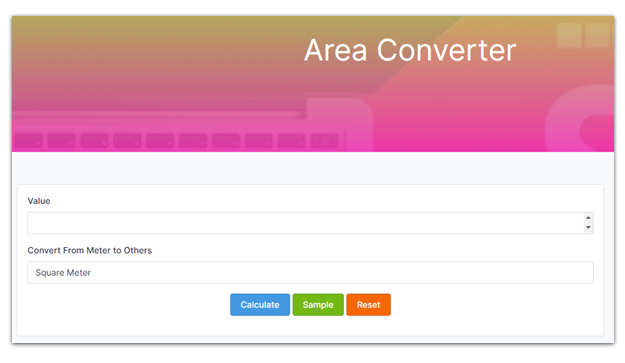
Area Converter
Area measurement is a crucial aspect of various fields, including architecture, real estate, agriculture, and land development. Different regions and industries adopt distinct units of area measurement, which can lead to challenges in communication and data analysis. To address this issue, an Area Converter serves as a valuable tool that simplifies the process of converting area measurements from one unit to another. In this article, we explore the significance of an Area Converter, its applications in different contexts, and how it streamlines area conversions with precision and ease.
The Importance of Area Conversions
Different countries and industries use diverse units of area, such as square feet, square meters, acres, hectares, and more. Conversions ensure a standardized and consistent approach to area measurement, facilitating seamless communication and data exchange.
In the real estate sector, property areas are often represented in various units. Accurate conversions are essential for buyers, sellers, and agents to understand and compare property sizes effectively.
Comprehensive Unit With Time and Effort Savings
An Area Converter offers a wide selection of input and output units for area measurements. It accommodates popular units such as square feet, square meters, acres, hectares, square inches, square yards, and more. Area converters typically have a user-friendly interface where users can input the value in the initial unit and select the desired output unit. The converter promptly provides the converted area value. By utilizing an Area Converter, users save valuable time and effort that would otherwise be spent on tedious manual conversions. The tool generates accurate results instantaneously.
In Real Estate Construction and Engineering
Area converters are valuable tools for real estate agents, property managers, and individuals involved in property transactions. They enable seamless comparisons of property sizes and accurate area calculations. In the construction industry, area converters assist architects and engineers in planning projects, estimating material requirements, and assessing building areas. Area converters are essential for farmers to calculate field sizes, determine crop yields, and manage agricultural resources efficiently. Area converters serve as educational aids, helping students grasp area measurement concepts and perform accurate conversions for academic purposes.
How to use This Area Converter?
When you try to use this area converter tool, you will see a very simple user interface like this picture below.

You will find 2 options with two blank boxes. One is to enter your desired value and the other is for the value unit.

In the convert option you will see the multiple units like square meter, square kilometer, hectare, acre etc. you will find more in the picture below.

Now enter your value in the value section and select the value unit like this.don’t forget to select the correct unit. Otherwise your result will show wrong.

After input you need to just click the calculate button for the result. Also you can reset if you see the input is wrong.

When you press the calculate button the result page will open soon. The result will show every unit details.

By this way you can get your desired result very quickly with zero error. So use our area converter tool and get benefit from every convert of any area.
Multi-Shape Area With Customizable Output Formats
Some advanced Area Converters go beyond simple geometric shapes (e.g., squares and rectangles) and support conversions for more complex shapes, such as triangles, circles, and irregular polygons. This versatility allows users to convert areas for a broader range of shapes encountered in real-world scenarios. Area Converters may offer customization options for the output format. Users can choose to view the converted area in different units, such as square kilometres, square miles, or acres, based on their specific needs or regional preferences.
Map and Area Scaling
In some cases, Area Converters are integrated with Geographic Information Systems (GIS) and mapping tools. This integration enables users to convert areas directly on maps, making it convenient for applications in geography, urban planning, and environmental studies. Certain Area Converters provide an additional feature called area scaling. This allows users to resize or scale the converted area proportionally, which is particularly useful in scenarios where resizing of maps or images is necessary without altering the actual area value.
Educational Resources and Unit Descriptions
Many Area Converters provide educational resources, such as unit descriptions and explanations of different area measurement systems. These resources help users understand the nuances of each unit, fostering better comprehension and knowledge exchange. Certain Area Converters retain a history of previous conversions, allowing users to refer back to their recent calculations. This feature is convenient when working on multiple projects or when frequent conversions are required.
Conclusion
In a world where area measurements are represented in various units, an Area Converter serves as a powerful tool to simplify conversions and promote standardization. It streamlines area calculations for professionals and individuals across diverse industries, enhancing accuracy and efficiency. Whether you're a real estate professional, architect, farmer, or student, an Area Converter is a valuable asset for accurate area conversions and effective decision-making. Embrace the convenience and precision of an Area Converter and unlock its potential in various applications for area measurement.











